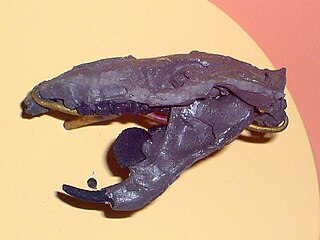
Meniscoessus is a genus of extinct multituberculates from the Upper Cretaceous Period that lived in North America.

Cimolomys is a mammal genus from the Upper Cretaceous of North America. It was a member of the extinct order Multituberculata within the suborder Cimolodonta and family Cimolomyidae.

Megazostrodon is an extinct genus of basal mammaliaforms belonging to the order Morganucodonta. It is approximately 200 million years old. Two species are known: M. rudnerae from the Early Jurassic of Lesotho and South Africa, and M. chenali from the Late Triassic of France.
Eozostrodon is an extinct morganucodont mammaliaform. It lived during the Rhaetian stage of the Late Triassic. Eozostrodon is known from disarticulated teeth from South West England and estimated to have been less than 10 cm (3.9 in) in head-body length, slightly smaller than the similar-proportioned Megazostrodon.

Megistotherium is an extinct genus of hyaenodont belonging to the family Hyainailouridae that lived in Africa.

Protungulatum is an extinct genus of eutherian mammals within extinct family Protungulatidae, and is possibly one of the earliest known placental mammals in the fossil record, that lived in North America from the Late Cretaceous to early Paleocene.

Dryolestida is an extinct order of mammals, known from the Jurassic and Cretaceous. They are considered basal members of the clade Cladotheria, close to the ancestry of therian mammals. It is also believed that they developed a fully mammalian jaw and also had the three middle ear bones. Most members of the group, as with most Mesozoic mammals, are only known from fragmentary tooth and jaw remains.

Stenoplesictidae is the name of a polyphyletic family of extinct civet-like feliforms.

Morganucodonta is an extinct order of basal Mammaliaformes, a group including crown-group mammals (Mammalia) and their close relatives. Their remains have been found in Southern Africa, Western Europe, North America, India and China. The morganucodontans were probably insectivorous and nocturnal, though like eutriconodonts some species attained large sizes and were carnivorous. Nocturnality is believed to have evolved in the earliest mammals in the Triassic as a specialisation that allowed them to exploit a safer, night-time niche, while most larger predators were likely to have been active during the day.
The North American land mammal ages (NALMA) establishes a geologic timescale for North American fauna beginning during the Late Cretaceous and continuing through to the present. These periods are referred to as ages or intervals and were established using geographic place names where fossil materials were obtained.
Herpestides is an extinct genus of terrestrial carnivore that was endemic to North Africa and Southern Europe during the Early Miocene subepoch and existed for approximately 2.4 million years.
Africanictis is an extinct genus of carnivorous cat-like mammals belonging to the infraorder Aeluroidea, endemic to Africa for approximately 11.42 million years, from 23.03 to 11.610 Ma, during the Miocene epoch.
Anictis is an extinct species of carnivorous cat-like mammal belonging to the infraorder Aeluroidea, endemic to Europe living from the Oligocene 33.9—28.4 Ma, existing for approximately 5.4 million years.

Stenoplesictis is an extinct genus of carnivorous cat-like mammals belonging to the infraorder Aeluroidea, from Europe and Asia (Mongolia), from the Oligocene 33.9—28.4 Ma, existing for about 5.5 million years.
The Williams Fork Formation is a Campanian to Maastrichtian (Edmontonian) geologic formation of the Mesaverde Group in Colorado. Dinosaur remains are among the fossils that have been recovered from the formation, most notably Pentaceratops sternbergii,. Other fossils found in the formation are the ammonite Lewyites, tyrannosaurids, dromaeosaurids, troodontids, nodosaurids, ankylosaurids, hadrosaurids, hybodonts, neosuchian crocodylomorphs, and the mammals Glasbius and Meniscoessus collomensis.
Egypt has many fossil-bearing geologic formations, in which many dinosaurs have been discovered.
Sivapterodon is an extinct genus of hyainailourid hyaenodont mammal of the subfamily Hyainailourinae that lived in Pakistan during the middle Miocene.
Jaggermeryx is an extinct genus of semiaquatic anthracothere, ungulates related to hippopotamuses, from the Early Miocene Moghara Formation in Egypt. The genus was named after Mick Jagger.
The Moghra Oasis is an uninhabited oasis in the northeastern part of the Qattara Depression in the Western Desert of Egypt. It has a 4 km2 (1.5 sq mi) lake containing brackish water, salt marshes and a swamp with reeds.

Gypsonictops is an extinct genus of leptictidan mammals of the family Gypsonictopidae, which was described in 1927 by George Gaylord Simpson. Species in this genus were small mammals and the first representatives of the order Leptictida, that appeared during the Upper Cretaceous.








